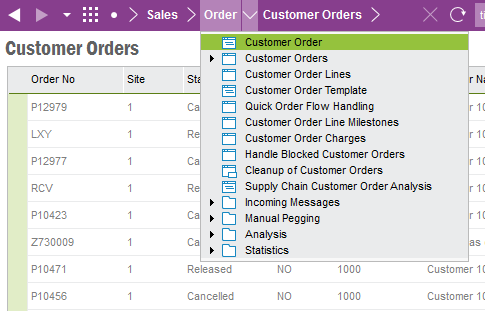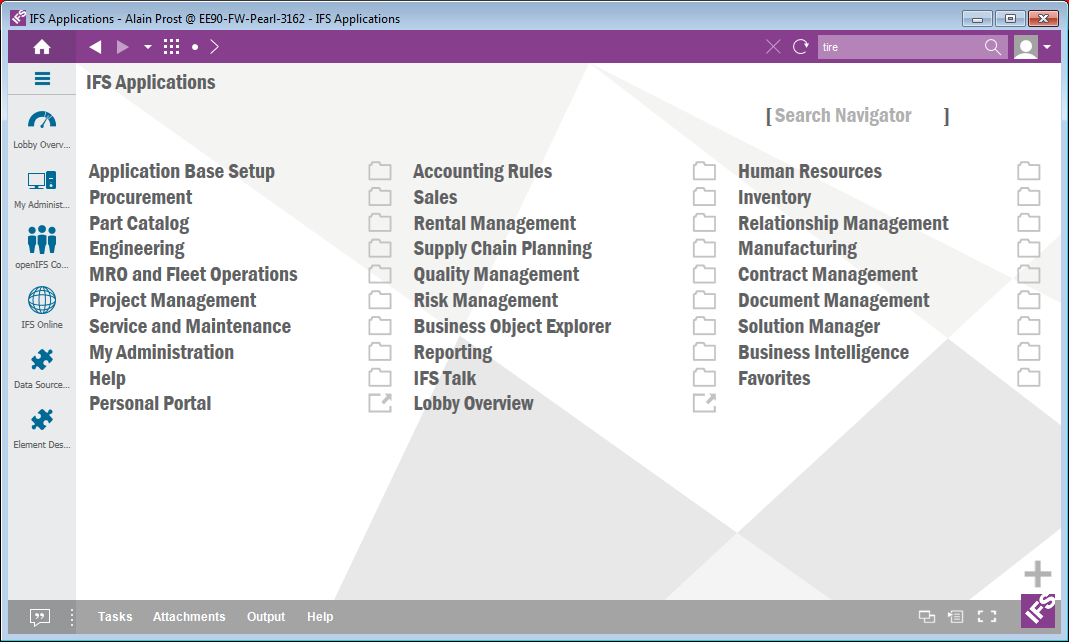
There are many different navigation options available and all can be combined. You decided which options that work the best for you in different situations, see below for a short overview of the different options.
Shortcuts give you quick access to IFS Application Pages, web pages, tools etc. you work with on a regular basis. Any changes you make are personal and stored in your user profile. Read more about Using Shortcuts

Fig 1. Shortcut panel example
The Navigator organizes the contents of IFS Applications in a tree structure. The content is organized in folders and sub folders with the IFS Application pages on the lowest level.
You navigate by clicking on folders to unfold them and you click on an IFS Application page node to open the page in the work area. Note that if you hover over the navigator node, the full name of the folder/page will be displayed.
The Navigator can be customized by you and/or your system administrator. You can create new folders and items and hide and rename existing ones. Read more about Using IFS Navigator. The Navigator includes links to some functions and pages that helps you with general tasks. Read more about Using Common Nodes

Fig 2. Navigator example
Use the Navigator Filter to quickly find the pages you want to work with. Read more about Using Navigator Filter

Fig 3. Navigator Filter example
The tools in the Explorer Toolbar helps you navigate back and forth in the history of visited pages. It also has functions to stop server activity and to refresh the current page. Read more about Using the Explorer Toolbar.
Fig 4. Explorer Toolbar
Breadcrumbs are placed in the navigation toolbar, just right of the Explorer Toolbar. The Breadcrumbs serve two purposes.
Read more about Using Breadcrumbs

Fig 5. Breadcrumbs
The Navigator page displays the contents of IFS Applications in a tree structure based on links. You simply click on a link to navigate to the page you want to work with. Folders below the links will unfold as you click on the links. Via Application Options you can choose if you want the Navigator Page to be "Classic" or "Touch Friendly". Read more in Using Navigator Page.

Fig 6. Navigator Page example
My start pages provide instant access to information in IFS Applications. It simplifies navigation and makes it easier to find information that is relevant for the user. A My Start Page contains elements such as Saved Searches, Selections, Quick Reports, URL:s and Application Search bars. Titles and notes can be used to organize your page to enhance the layout. It is possible to have several My Start Pages and these pages may be linked to each other. A My Start Page can be defined as the home page for IFS Applications and will then be the entry point to the application. My Start Pages are personal and stored in the user profile. My Start Pages may be configured by the System Administrator and pushed out to end users via the base profile. Read more about My Start Page.

Fig 7. My Start Page example
Recent screens contains the history of all pages you have been working with shown as thumbnails. Use Recent Screens to quickly jump between the pages you are working with. Read more about Using Recent Screens

Fig 8. Recent Screens example